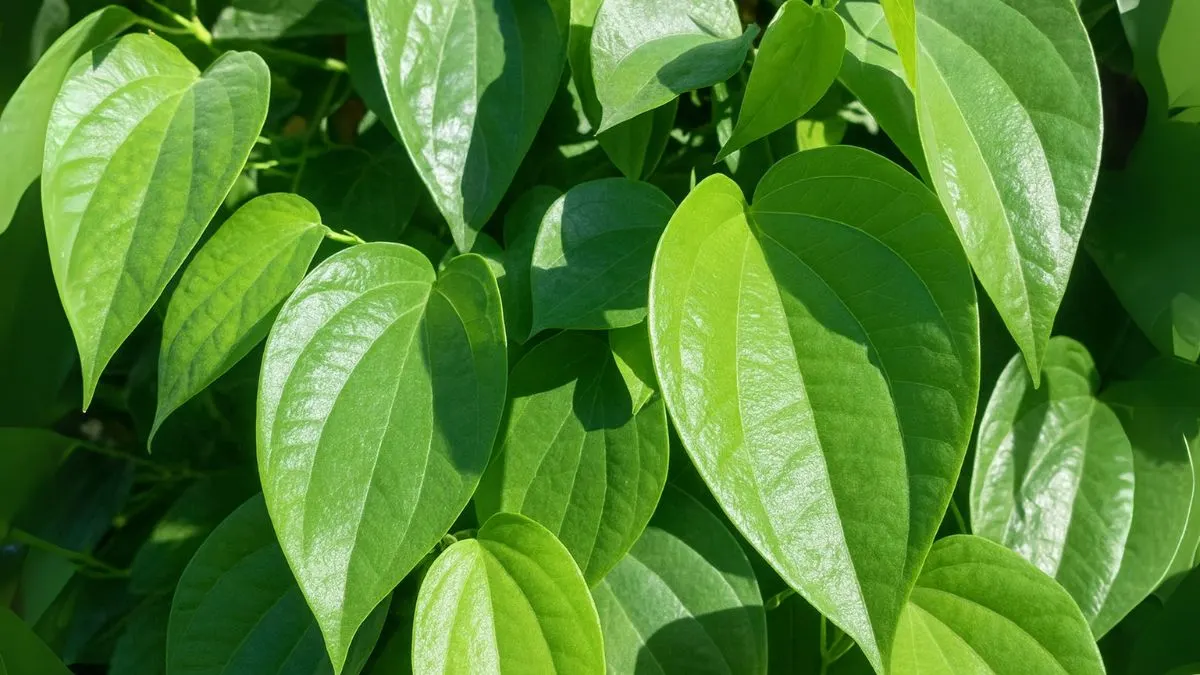If you’ve ever visited an Indian household or attended a traditional ceremony, chances are you’ve seen the Betel leaf plant making an appearance. Known as Paan in India, it’s a climbing vine with glossy, heart-shaped leaves that are valued for both their cultural and medicinal importance.
In this blog, we’ll explore how to care for the plant, the numerous health benefits of its leaves, and easy methods of propagation. Having grown one on my own balcony in Canada, I can confirm it’s not only doable but rewarding.
Understanding the Betel Leaf Plant

The betel vine (Piper betle) belongs to the pepper family. It’s native to South and Southeast Asia but has now made its way into homes and gardens worldwide.
- Growth Habit: A perennial creeper with heart-shaped, glossy leaves.
- Cultural Relevance: Used in rituals, offerings, and Ayurvedic medicine.
- Flavor Profile: Mildly spicy and aromatic.
Care Guide for Betel Leaf Plant
-
Light Requirements
Betel leaf plants are shade-loving plants that love partial light. Direct sun can scorch their leaves, so it’s best to plant them in partial shade or dappled sunlight. Indoors, a spot near an east-facing window works perfectly.
-
Soil Preparation
The plant loves nutrient-rich soil. Always ensure you’re providing partial shade, maintaining consistently moist but well-draining soil, and fertilizing with nitrogen-rich compost. Adding organic compost once a month boosts its growth.
-
Watering
Consistency is key. You should water the plant every four days, or more often and thoroughly in the summer. Overwatering, however, can cause root rot. The soil should feel moist to touch, but never soggy.
-
Temperature & Humidity
Being tropical, it enjoys warmth and high humidity. Ideal growth happens in temperatures between 15–35°C. If you live in a dry region like parts of Canada or the USA, misting the leaves can keep the plant happy.
-
Fertilizer
A compost high in nitrogen is ideal, as it helps in producing lush green leaves. During peak growing months (spring and summer), fertilize every 3–4 weeks.
Benefits of Betel Leaves
Betel leaves are a powerhouse of health benefits and have been valued in Ayurveda for centuries.
- Digestive Aid: Chewing the leaves helps stimulate digestion.
- Oral Health: They freshen breath and are used in traditional remedies for gum health.
- Antioxidants: Rich in polyphenols, they combat oxidative stress.
- Respiratory Relief: Inhaling steam infused with betel leaves can clear nasal congestion.
- Cultural Significance: In India, offering betel leaves during festivals signifies respect and prosperity.
I remember my grandmother using warmed betel leaves as a natural remedy for chest congestion during winters — a practice still relevant today.
Propagation of Betel Leaf Plant
One of the reasons the plant is so popular is its ease of propagation.
Method 1: Stem Cuttings
- Cut a healthy vine with 4–5 leaves.
- Place it in water or directly into moist soil.
- Keep the pot in partial shade.
- Roots will appear in 2–3 weeks.
Method 2: Layering
Another easy way is layering, where you bend a healthy vine to the ground, cover a section with soil, and let it root while still attached to the parent plant.
Method 3: Nursery Plants
For beginners, buying a live indoor plant from a nursery in a well-stable potted condition is the safest option.
Quick Care Summary
Aspect |
Requirement |
Light |
Partial shade, dappled sunlight |
Soil |
Well-draining, nitrogen-rich compost |
Watering |
Every 4 days; more often in summer |
Temperature |
15–35°C, warm and humid |
Propagation |
Stem cuttings, layering, nursery plants |
Key Benefit |
Medicinal + cultural uses |
Growing Betel Leaf Plants in Canada & USA
While it is a tropical plant, many gardeners in North America have successfully grown it indoors. With the right care — particularly partial shade and moist, well-draining soil — it adapts well to containers. A humidifier or pebble tray can help in maintaining ideal humidity.
Common Problems and Fixes
- Yellowing Leaves: Usually due to waterlogging. Fix by improving drainage.
- Dry, Crispy Edges: Caused by too much direct sunlight. Move to shade.
- Slow Growth: Add compost or organic fertilizer regularly.
Personal Experience with Betel Leaf Plant
When I first planted mine on my balcony in Toronto, I underestimated its need for humidity. The leaves dried out quickly. After shifting it indoors to a shaded corner and misting daily, the plant revived beautifully. Today, it’s thriving in a terracotta pot, providing me with fresh, aromatic leaves year-round.
The Betel leaf plant is more than just a climber — it’s a blend of culture, health, and beauty. If you’re new to indoor gardening, start with betel. It’s a shade-loving plant that loves partial light and rewards you with lush growth and leaves packed with wellness.






